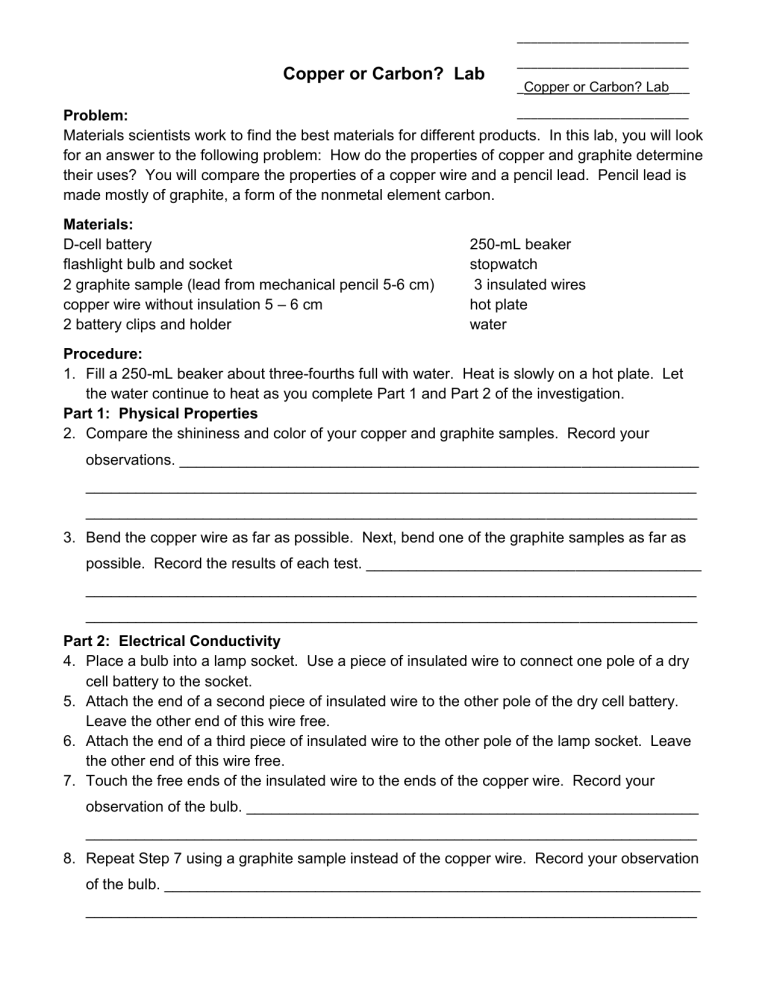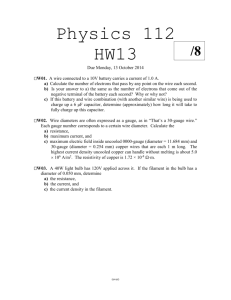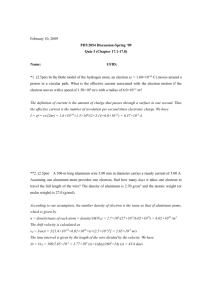Copper or Carbon Lab

_________________________
_________________________
Copper or Carbon? Lab
Problem:
_ Copper or Carbon? Lab ___
_________________________
Materials scientists work to find the best materials for different products. In this lab, you will look for an answer to the following problem: How do the properties of copper and graphite determine their uses? You will compare the properties of a copper wire and a pencil lead. Pencil lead is made mostly of graphite, a form of the nonmetal element carbon.
Materials:
D-cell battery flashlight bulb and socket
250-mL beaker stopwatch
2 graphite sample (lead from mechanical pencil 5-6 cm) copper wire without insulation 5 – 6 cm
2 battery clips and holder
Procedure:
3 insulated wires hot plate water
1. Fill a 250-mL beaker about three-fourths full with water. Heat is slowly on a hot plate. Let the water continue to heat as you complete Part 1 and Part 2 of the investigation.
Part 1: Physical Properties
2. Compare the shininess and color of your copper and graphite samples. Record your observations. ______________________________________________________________
_________________________________________________________________________
_________________________________________________________________________
3. Bend the copper wire as far as possible. Next, bend one of the graphite samples as far as possible. Record the results of each test. ________________________________________
_________________________________________________________________________
_________________________________________________________________________
Part 2: Electrical Conductivity
4. Place a bulb into a lamp socket. Use a piece of insulated wire to connect one pole of a dry cell battery to the socket.
5. Attach the end of a second piece of insulated wire to the other pole of the dry cell battery.
Leave the other end of this wire free.
6. Attach the end of a third piece of insulated wire to the other pole of the lamp socket. Leave the other end of this wire free.
7. Touch the free ends of the insulated wire to the ends of the copper wire. Record your observation of the bulb. ______________________________________________________
_________________________________________________________________________
8. Repeat Step 7 using a graphite sample instead of the copper wire. Record your observation of the bulb. ________________________________________________________________
_________________________________________________________________________
Part 3: Heat Conductivity
9. Turn off the hot plate.
10. Hold one end of a graphite sample between the fingertips of one hand. Hold one end of the copper wire between the fingertips of the other hand. CAUTION: Be careful not to touch the beaker.
11. Dip both the graphite and copper wire into the hot water at the same time. Allow only about
1 cm of each piece to reach under the water’s surface. From your fingertips to the water, the lengths of both the graphite sample and the copper wire should be approximately equal.
12. Time how long it takes to feel the heat in the fingertips of each hand. Record your observations. ______________________________________________________________
_________________________________________________________________________
_________________________________________________________________________
Analyze and Conclude
1. Compare the physical properties of copper and graphite that you observed. _____________
_________________________________________________________________________
_________________________________________________________________________
_________________________________________________________________________
2. Based on the observations you made in this lab, explain why copper is classified as a metal.
_________________________________________________________________________
_________________________________________________________________________
_________________________________________________________________________
3. In Step 11, why was it important to use equal lengths of copper wire and graphite? ________
_________________________________________________________________________
_________________________________________________________________________
_________________________________________________________________________
4. Which of the two materials, graphite or copper, would work better to cover the handle of a frying pan? Explain your choice. _______________________________________________
_________________________________________________________________________
_________________________________________________________________________
5. Write a paragraph explaining why copper is better than graphite for electrical wiring. Include supporting evidence from you observations in this lab. ______________________________
_________________________________________________________________________
_________________________________________________________________________
_________________________________________________________________________
_________________________________________________________________________





